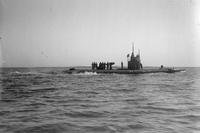In the 1990 film "The Hunt for Red October," a Soviet Navy captain who is disenchanted with the Soviet system defects to the United States with a new, secret submarine propulsion system.
Freedom beats communism, once again.
One Soviet Navy officer in the mid-1970s didn't think the Soviet Union practiced anything like what communism was supposed to be. He decided he would steal a ship, but defecting to the United States was the last thing on his mind. He wanted to start another communist revolution, right in the heart of the Soviet Union.
Tom Clancy was an insurance salesman when he read about Soviet captain 3rd Rank Valery Sablin. Sablin's story inspired him to write a book that would propel Clancy to literary stardom while introducing his most beloved character, Jack Ryan. "The Hunt for Red October" hit the bookshelves in 1984, but Sablin was long dead by then.
Sablin was the last person one might expect to start a revolution. He was a third-generation Russian sailor and a fervent believer in communism. His vision of communism, however, was not the communism practiced by the Soviet Union.
As a young graduate of the Lenin Military-Political Academy and a political officer in the Soviet military, he believed in the original Leninist values of the revolution, that true communism required self-determination for all people. Somehow, that had been lost since the 1917 revolution that created the USSR.

In Sablin's view, whatever the government of Soviet leader Leonid Brezhnev was, it was not what Lenin had envisioned. He saw the Soviet government as corrupt and full of thieves and demagogues who were lying to Soviet citizens. Just two years after graduating from the academy, he did something about it.
His plan was to steal a Soviet Navy ship, sail it into Leningrad and call on the people to rise up against the government in Moscow. He was going to broadcast his protest to the whole of the USSR, speak out against the Brezhnev regime's corruption and form a new, Leninist government.
In "The Hunt for Red October," the defecting captain has to kill the political commissar before he can put his defection plan into action. Sablin actually was the political commissar. Assigned to the missile frigate and sub chaser Storozhevoy on Nov. 9, 1975, he lured the ship's captain below deck while it was docked in the Bay of Riga.
With the captain locked away, Sablin played the 1925 film "Battleship Potemkin" for the crew, a movie about the Russian Navy deciding to fight the unjust Tsarist government in the 1917 revolution.
He then briefed the 15 remaining senior officers of his intentions and forced them to choose a side. Eight of them agreed to the plan; the other seven were also locked away. He then addressed the 150 or so crew members.
It turns out that much of the crew either agreed with him or were so disenchanted themselves, they were willing to go along with a revolution. Watching a movie about sailors leading a revolution didn't hurt, either. After a rousing speech, the sailors joined Sablin's revolution.
"The Kremlin geriatrics in the Politburo with Brezhnev at the head were never going to lead the country to prosperity," Russian naval historian Nikolai Cherkashin said in a documentary. "I won't say everyone felt like that, but the Navy officer corps certainly did."
The ship was supposed to depart the next morning, but with the escape of one of the crew, the revolutionaries left under the cover of darkness. Just like in the movie "The Hunt for Red October," when the Soviet government discovered the mutiny, it started a frenzied search.
It didn't help that the Storozhevoy was the USSR's latest and greatest anti-submarine frigate. The Soviet leadership feared Sablin defecting to the West with the missile frigate just as much as they feared his revolutionary threat.
It launched half of the Soviet Baltic fleet to find and destroy the Storozhevoy, if necessary. Some 13 vessels and 60 combat aircraft were launched in pursuit of Sablin's frigate as it sailed for Leningrad. The missile frigate had no ammunition and was defenseless against the government forces. Sablin's revolution was supposed to be bloodless.

Although Sablin had turned off the radar upon leaving the Bay of Riga, he had to turn it back on in the dense fog of the Baltic Sea. By 8 a.m., the Soviet forces located the Storozhevoy. Bombs began to drop on the ship as Soviet fighters strafed its decks. It was soon disabled and cornered by loyal ships.
A mutiny within the mutiny began, as three members of the crew freed the ship's captain, who promptly shot Sablin in the leg. He then radioed the attacking forces that he had retaken control of the Storozhevoy. The ship was boarded by Soviet Naval Infantry, which interrogated the crew and arrested Sablin.
Sablin was tried and convicted in June 1976, and given a death sentence. It was carried out two months later. Sablin was a popular member of the crew, and even 20-plus years later, members of the ship's crew remembered him fondly.
The KGB suppressed the true story of the Storozhevoy, instead telling Western sources the crew had been trying to defect. Master's student Gregory D. Young used the USSR's official story as part of his thesis, "Mutiny on Storozhevoy: A Case Study of Dissent in the Soviet Navy." Clancy found the study in the Naval Academy archives, and it became the inspiration for "The Hunt for Red October."
-- Blake Stilwell can be reached at blake.stilwell@military.com. He can also be found on Twitter @blakestilwell or on LinkedIn.
Want to Learn More About Military Life?
Whether you're thinking of joining the military, looking for post-military careers or keeping up with military life and benefits, Military.com has you covered. Subscribe to Military.com to have military news, updates and resources delivered directly to your inbox.
















